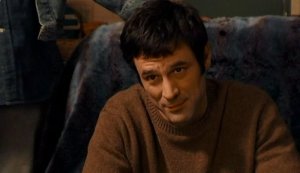The film starts with Professor Richard Wanley, played by Edward G. Robinson, parting with his family to lecture in psychology in New York for the summer. He meets with a couple of his good friends, District Attorney Frank Lalor (Raymond Massey) and Dr. Michael Barkstane (Edmund Breon) for dinner on his first night in town. Outside his hotel, before their rendevous, Wanley takes some to stare at a portrait of a woman. He explains to his acquaintances his fondness of the artist's work to which they jocularly call attention to the attractiveness of the woman in it. He admits that might have something to do with it as well. The three catch up over dinner and move on to cigars and drinks. Wanley is asked if he'd like to extend the night by presumably spending it in a club or other night venue of entertainment but he denies, citing his middle age and maturity. After his friends leave he spends some time in the lobby then goes out for a smoke and another look at that mesmerizing portrait. To his astonishment, he finds the portrait's subject, Alice (Joan Bennett), in person watching him. She invites him over to her apartment to gaze over more works by the artist in which she models and contradicting the very philosophy he advocated to his friends earlier, takes her up on the offer. While there, a man, who is later identified as Claude Mazard (Arthur Loft), storms into the flat and rabidly assaults Wanley by choking him. Alice hands a pair of scissors to Wanley who manages to stab the assailant several times in the back, releasing him of the attack and killing the man in the process. This prompts the most pivotal line in the film, from Alice: "What are we going to do?"
Though it is an act of self-defense, neither Alice nor Wanley want the police's involvement for their own respective reasons, so they decide to dispose of the body and the crime scene. From this point on the The Woman in the Window becomes a psychological thriller. Thanks to the direction of Fritz Lang, with its dark lighting, dramatic close-ups and jaunting camera angles, we can't help but fret through every weave the story takes. Of course Lalor the D.A. offers to Wanley (and us) "confidential" information regarding the progress the homocide unit is making in the case and at one point even escorts Wanley back to the crime scene where the body was found. Nerve-racking schemes like this in the film are wonderfully put together and executed.
| Joan Bennett and Edward G. Robinson. |
Without giving away too much, the film ends with what I would call a controversial approach. That is about as much as I can say without spoilers, so stop here if you prefer to avoid them. As Alice is regrouping herself after a terrifying encounter with Heidt and Wanley contemplates suicide, events take a significant turn. Heidt is shot and killed by the police in an unrelated skirmish and found with Mazard's pocket watch (initials engraved) on person. While the film is in the height of its culmination as Wanley sits in a chair after ingesting an overdose of heart medicine and the phone is ringing incessantly with Alice on the other end eager to break the news about Heidt's death...a slow zoom-in to Robinson's troubled face followed by a zoom-out has us back in the lobby at 10:30pm, prior to when the mischeif had all began. In other words, it was all a dream. Wanely has a Wizard of Oz moment when he recognizes the faces of those in his dream as part of the hotel staff and the film chooses a light-hearted, comical finish: Wanley goes outside to take a gander at the portrait (just as he did to start his dream) at which point a woman asks if he has a light for her cigarette. He rejects her and madly runs off in the opposite direction.
While I'm not going to categorize the dream as a cop-out, it is certainly a ruse. Its smooth, on-screen reveal (to which the credit goes to Lang helps) lessens that sentiment, but nevertheless we cannot help but feel abruptly torn away from the story to which we have been so committed. On the other hand, this review is being written in 2012 and this film was put out in 1944, so it should be noted that today's viewers are likely more jaded by the dream outlet. What can be agreed on by all, is that The Woman in the Window is a fresh story with quality performances bundled up in classic noir cinema. And no unexpected waking moment is going to take that away.
--Review by Mike Dorfman



